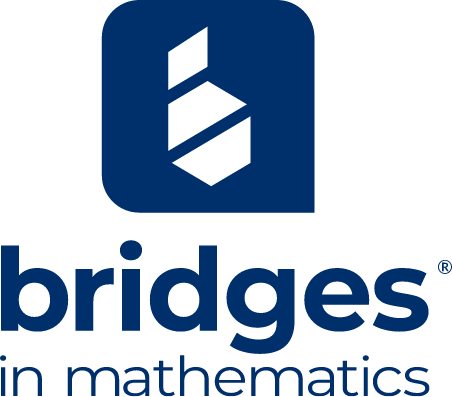
Considering Third Edition?
Information for Bridges & Number Corner Second Edition Users
Third Edition reflects a number of enhancements while retaining a student-centered approach emphasizing classroom discourse, visual models, and conceptual understanding.
What Are the Enhancements?
Third Edition opens up tasks and includes popular routines to provide more ways for students to be correct. A refined approach to assessment honors students’ thinking already in place.
Professional learning is embedded with expanded unit introductions and sidebar content. This content connects to equity-based practices, effective mathematics teaching practices, standards for mathematical practice, and other features supporting teachers in understanding the rationale behind each lesson.
Differentiation opportunities and resources are clarified and expanded, including connections to content from earlier grades, Bridges Intervention, and Concept Quests K-5.
Integration of MLC apps with the curriculum provides flexibility for how students and educators engage with and talk about mathematical models and activities.
Third Edition offers ways for all students to see themselves as mathematicians. Task contexts and illustrations feature a wide range of identities and settings, and embedded ideas help educators create an equitable learning environment.

Second Edition
Third Edition
Problem-based activities engage learners.
Activities position students as competent, capable sensemakers. They put learning into students’ hands through open-ended problems, strategy sharing, and discussion structures — enabling them to learn from each other.
Bridges® sessions are organized in a consistent structure with assessments, Work Places, and independent practice. Sessions are clearly labeled.
Headings and subheadings in the Teachers Guide show practical and contextual breaks in instruction, enabling teachers to flexibly structure math time and other activities. Instructional routines and closing activities are clearly delineated.
Some Bridges® sessions require more time than allocated for implementation.
Sessions have been revised or divided over multiple days to support teachers in delivering lessons within 60 minutes.
Number Corner® materials are organized by activity type.
Number Corner® materials are organized by month and day for easier planning and implementation.
The Bridges Educator Site offers a searchable resource library, blog, and professional learning resources.
The new Bridges Educator Site (BES) provides additional resources — including online courses, unit videos, grade-level overviews, and resource guides — connected to each session for individual educators and professional learning communities.
Second Edition was written specifically to align with the Common Core State Standards for Mathematics.
Third Edition lists the Common Core State Standards for Mathematics. However, learning goals and content information are organized so states and districts can easily determine the alignment of materials to their state standards.
Unit introductions provide background mathematical information and pedagogical connections to other grade levels.
Unit introductions are more robust and comprehensive, illustrating the visual representations and mathematical strategies that students will learn and the pedagogical approaches used throughout the unit.
Activities were written to be highly interesting for young learners, including contexts related to animals, fictional literature, and school and family events.
In contexts and images, revised activities provide more windows and mirrors through which students can see themselves and others.
Sidebars include general information about the session, assessments, digital resources, and opportunities for students to engage in the mathematical practices during instruction.
Additional sidebars serve as embedded professional learning, highlighting instructional routines, math teaching practices, equity-based practices, and digital resources.
The Math Vocabulary Cards app divides all terms into sets for K–2 and 3–5.
The Math Vocabulary Cards app allows filtering by grade and by unit so that teachers and students can access the terms relevant to a particular section of the curriculum.
A number of trade books are included as part of Bridges® classroom kits.
Two MLC-created storybooks have been written for kindergarten. In the other grades, literature and real-world connections are embedded in the Teachers Guide.
Work Places are highlighted as an opportunity for differentiation.
Work Places and Concept Quests provide opportunities for differentiation. Both engage students in meaningful practice and extension of the skills and concepts taught within units.
Fact fluency instruction centers on fact sets and strategies. Some timed activities are included.
Foundational facts and derived fact strategies are elicited from student sensemaking and discussion of various strategies. Timed activities are not included in the materials.
Monthly Number Corner® videos are available on the Bridges Educator Site (BES).
Monthly Number Corner® videos continue to be available on the BES. In addition, grade-level videos describe the structure and mathematics of a particular grade. New Bridges® unit overview videos provide information about the content and how mathematical understanding develops across the year.
Unit pre-assessments are provided as a means to measure learning from the beginning to the end of the unit.
Unit screeners serve as pre-assessments to help teachers determine students’ prior knowledge, skills, and conceptual understanding related to upcoming instruction.
Assessments appear in both Number Corner® and Bridges® units.
Additional forms of assessment have been integrated with unit assessments. Understanding is assessed formally through screeners, checkpoints, and unit assessments within the Bridges® units; it is informally through observations and work samples.
What Is the Price to Transition?
Third Edition transition kits include new teachers guides as well as selected classroom materials. Pricing is $450 per Bridges classroom or $200 for Number Corner only. Eligible schools and districts also receive a 50% discount on first year student book orders.
